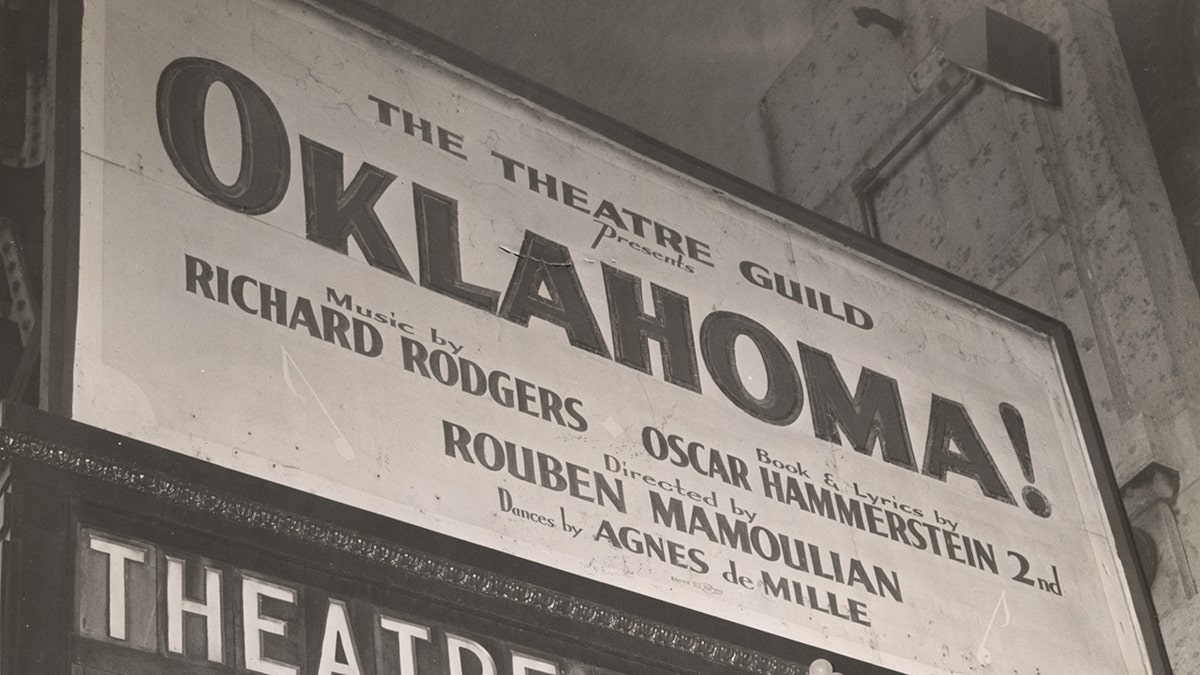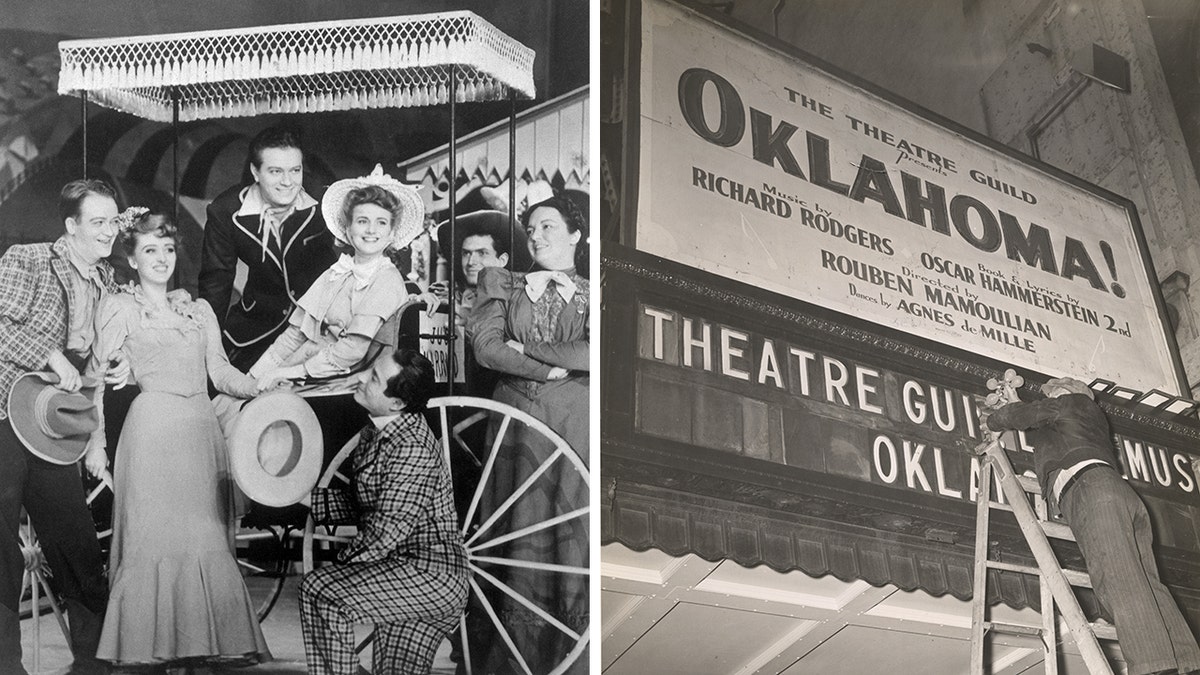The musical 'Oklahoma!' by Rodgers and Hammerstein changed Broadway forever — here's how
Rodgers and Hammerstein's "Oklahoma!" opened on Broadway at the St. James Theatre in New York City on March 31, 1943, changing the future of musical theater.
The great American musical "Oklahoma!" — which changed the trajectory of musical theater forever — graced the Great White Way for the first time on this day in history, March 31, 1943.
The Pulitzer Prize-winning musical premiered 81 years ago at the St. James Theatre in New York City.
It ran in that theater for almost five years, setting records with its 2,212 total performances.
"The next morning, rave reviews for ‘Oklahoma!’ poured in, and the box office was frenzied with theatergoers eager to claim their ticket to see the new musical critics were calling ‘a striking piece of theatrical Americana,'" the Rodgers & Hammerstein Organization wrote.
ON THIS DAY IN HISTORY, MARCH 30, 1858, AMERICAN VISIONARY HYMEN LIPMAN PATENTS PENCIL WITH ERASER
The musical "Oklahoma!" is based on the play "Green Grow the Lilacs" written in 1930 Lynn Riggs.
The show marked the first collaboration between Broadway musical legends Richard Rodgers and Oscar Hammerstein II — the dynamic duo who went on to write 11 musicals for the stage. They also collaborated on scores of other creative works, winning 34 Tony Awards, 15 Academy Awards, two Pulitzer Prizes and more.

The marquee at Broadway's Saint James Theatre, at 246 West 44th Street, in New York, 1943. The sign on the marquee reads, "The Theatre Guild presents ‘Oklahoma!’ Music by Richard Rodgers, book and lyrics by Oscar Hammerstein II, directed by Rouben Mamoulian, dances by Agnes De Mille." (Weegee/International Center of Photography/Getty Images)
Originally entitled "Away We Go," "Oklahoma!" forged a new format for musicals.
Broadway shows in the 1920s, ’30s and '40s produced by Florenz Ziegfeld were more along the lines of musical revue, with heavy song-and-dance and slapstick comedy but no real narrative.
BROADWAY UNMASKED! 10 FASCINATING FACTS ABOUT AMERICA'S MOST FAMOUS STREET
Under Ziegfeld, the musical "Show Boat" started to integrate a deeper storyline while still retaining the song-and-dance flare that audiences favored.
"A song about the bright gold haze on an Oklahoman meadow … may strike few people in the 21st century as revolutionary, but compared to what else was playing at the time, it was." — The Rodgers & Hammerstein Organization
"While [Richard Rodgers and Oscar Hammerstein] weren't necessarily out to revolutionize the American musical, they were interested in melding the elements of story, song and dance in a more integrated way," an NPR segment noted.
"Before ‘Oklahoma!,’ most musicals had been haphazard affairs, where the songs related to the plot in only the sketchiest of ways," the same source said.
ON THIS DAY IN HISTORY, MARCH 2, 1965, ‘THE SOUND OF MUSIC’ DEBUTS IN AMERICAN MOVE THEATERS
Most shows at the time opened with a "bang" or a line of pretty chorus girls wowing audiences with their dance or song, yet Rodgers and Hammerstein challenged audience expectations by depicting the simple life of a rural cowboy in America.
The show opened with the most unexpected sequence in musical history.

Actor Alfred Drake singing "Oh, What a Beautiful Mornin'" in the musical "Oklahoma!" (George Karger/Getty Images)
"A song about the bright gold haze on an Oklahoman meadow, begun offstage and continued as a serenade by a bowlegged cowboy to a mature lady working away at a butter churn on her porch, may strike few people in the 21st century as revolutionary, but compared to what else was playing at the time, it was," the Rodgers & Hammerstein Organization shared.
The show's song-and-dance sequences were motivated and dictated by the story itself.
"Like Michelangelo chiseling away all the superfluous marble that wasn’t essential to his statue, the creative team was boldest in paring away all the obstacles that got in the way of their story."
The musical tells the story of a confident yet romantic Oklahoma cowboy, Curly McLain, and a gentle but stubborn farm girl, Laurey Williams.
They love each other but are unable to say so — and ultimately find themselves in a love triangle with the brooding farmhand Jud Fry.

The original company in the 1943 production of "Oklahoma!" From left are Lee Dixon (Will Parker), Celeste Holm, (Ado Annie), Alfred Drake, (Curly), Joan Roberts (Laurey), Joseph Buloff (Ali Hakim) and Betty Garde (Aunt Eller). "Oklahoma!" is considered the first "concept" musical in the history of American musical theater. (Bettmann/Getty Images)
In contrast, a secondary plot line showcases another love triangle between the adventurous Will Parker — a role written by Hammerstein for the show — and the flirtatious Ado Annie; their love is interrupted by Persian peddler Ali Hakim.
The show demonstrated its ability to integrate dialogue into song.
While many people today know songs such as "Surrey with the Fringe on Top" or "People Will Say We're in Love" outside the show's context, the songs within the musical help propel the story forward.
‘MY WORLD HAS CHANGED FOREVER’: OHIO GIRL'S BIG SUCCESS IN BIG APPLE AS A RADIO CITY ROCKETTE
"Nearly all of the songs in 'Oklahoma!' are interrupted by, or carried through by, sections of dialogue [which are then] woven through lyrics," the Rodgers & Hammerstein Organization noted.
"[Oklahoma] is a small human story, a sketch of characters and a swift-moving symbol of the spirit of the pioneer America about 1900." — Oscar Hammerstein II
Hammerstein served as book writer and lyricist and "knew better than anyone in the business how to move from dialogue to the emotional expression of song and — importantly — how to move back again," Laurence Malson wrote for the Rodgers & Hammerstein Organization.
Choreographer Agnes de Mille also created a dream ballet sequence that showcased the deeper emotions of the principal characters.
RUSSIAN PRIMA BALLERINA LEAVES MOSCOW THEATER OVER RUSSIA-UKRAINE WAR
For 18 minutes, audiences were taken into the psyche of the story's ingénue, Laurey, her internal conflict showcased through dance.
This psychological moment of the story became a centerpiece of the show.

In the original 1943 production of "Oklahoma!" these "postcard girls" helped pave the way for dancers in later "concept" musicals. Among the big songs: "Oh, What a Beautiful Mornin,'" "People Will Say We're in Love," and "The Surrey with the Fringe on top." (Bettmann/Getty Images)
At its heart, "Oklahoma!" is an Americana folk story about the simple qualities in life.
"It is a small human story, a sketch of characters and a swift-moving symbol of the spirit of the pioneer America about 1900," Hammerstein wrote in 1948.
His favorite song in the show, "The Surrey with the Fringe on the Top," depicts that aspect of finding great joy even in little things.
"I don't cry at sadness in the theater. I cry at naive happiness," Hammerstein stated in a vintage recording.

"Oklahoma!" poster — the original Broadway theater poster — 1943. (LMPC/Getty Images)
"The fact that two people are looking forward with great anticipation to a ride in a surrey to a dance makes me cry."
It was this quality of simplicity that amazed audiences the evening of March 31, 1943.
OSCAR QUIZ! HOW WELL DO YOU KNOW THE FACTS ABOUT THE ACADEMY AWARDS?
"'Oh, What a Beautiful Mornin' produced a sigh from the entire house I don't think I've ever heard in a theater. It was just 'Ahh.' It was perfectly lovely and deeply felt," Agnes de Mille said following the opening of the show.
Before the show officially made its way to New York City, critics were anticipating a musical "flop."

Music composers Oscar Hammerstein and Richard Rodgers watching a rehearsal of the musical "Oklahoma!" on Broadway, New York, 1943. (Graphic House/Archive Photos/Getty Images)
During the show's out-of-town tryout in New Haven, Connecticut, columnist Walter Winchell's assistant wrote to him saying, "No girls! No legs! No chance!"
"This would prove to be one of the most off-base predictions in theater history," noted History.com.
CLICK HERE TO SIGN UP FOR OUR LIFESTYLE NEWSLETTER
"Oklahoma!" also created the first-ever "original cast recording" after bringing together the principals, ensemble and orchestra in a recording studio to sing the show, according to the Library of Congress.
Broadway had created a show that brought people "home."

On March 31, 1943, Rodgers and Hammerstein's "Oklahoma!" opened on Broadway, becoming one of the greatest musicals in theater history. (Bettmann/Weegee/International Center of Photography/Getty Images)
"The show's sunny optimism and homespun Americana were a perfect tonic for the jittery uncertainty of World War II," NPR noted.
Audiences have been mesmerized ever since by the simple folktale that premiered more than 80 years ago.
CLICK HERE TO GET THE FOX NEWS APP
The Rodgers & Hammerstein Organization noted, "'Oklahoma!' invited its audience for a longer, more compelling journey — it asked its audience to hop inside a shiny little surrey with the fringe on the top and go along for the ride."
For more Lifestyle articles, visit www.foxnews.com/lifestyle


